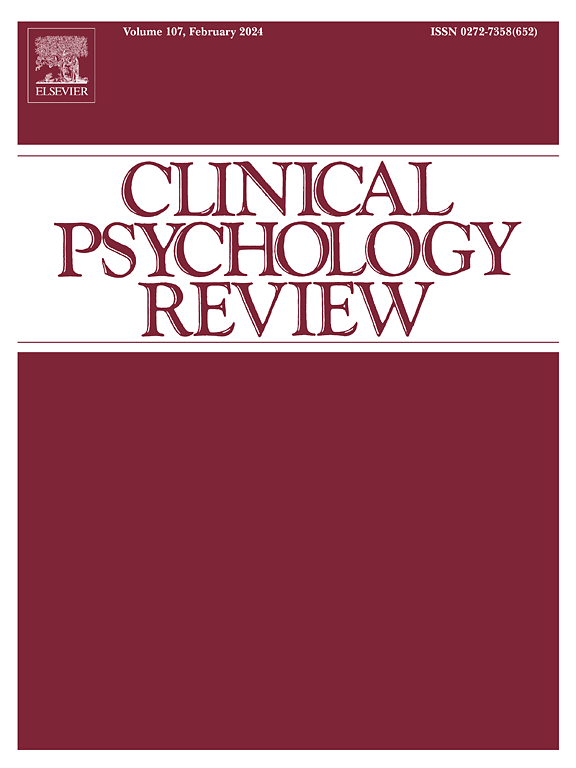Dyadic coping and relationship satisfaction among couples with a chronic illness: A meta-analytical actor–partner interdependence model
IF 12.2
1区 心理学
Q1 PSYCHOLOGY, CLINICAL
引用次数: 0
Abstract
Chronic illness (CI) burdens both the patient and their romantic partner. CI management has been viewed as a dyadic process by theorists and clinical practitioners. Dyadic coping (DC) refers to the processes where one partner aids the other or both partners work together to cope with stress. We used the meta-analytical actor–partner interdependence model and its extension of actor–partner interdependence moderation model to evaluate the aggregated actor and partner effects of DC on relationship satisfaction (RS) in CI partners (CIP) and healthy partners (HP). This meta-analysis included 61 samples from 57 reports. The combined zero-order correlation (r) between total DC and RS was 0.37 (95 % CI: 0.33–0.40, p < .001). The total DC for both partners with and without CI showed significant actor effects on their own RS (CIP → CIP: b = 0.33, SE = 0.03, p < .001; HP → HP: b = 0.32, SE = 0.03, p < .001) and significant partner effects on the other's RS (HP → CIP: b = 0.18, SE = 0.03, p < .001; CIP → HP: b = 0.20, SE = 0.03, p < .001). Similar patterns were observed for positive DC and negative DC. These effects were observed regardless of study quality, years since diagnosis, age, sex, and relationship length. Moreover, type of publication, publication year, country, DC measures, CI types, and both partners' education attainment moderated observed associations. Couple-based interventions for CI should incorporate psychoeducation on the importance of DC (e.g., viewing illness as a “we-disease,” communicating about stress, and providing mutual support) and skill-building components to enhance RS, recognizing the interdependent nature of both partners' coping processes.
慢性疾病夫妻的二元应对与关系满意度:一个元分析行为者-伴侣相互依赖模型
慢性疾病(CI)给病人和他们的伴侣都带来了负担。CI管理被理论家和临床实践者视为一个二元过程。二元应对(DC)是指一方帮助另一方或双方共同应对压力的过程。我们运用元分析的行动者-伴侣相互依赖模型及其对行动者-伴侣相互依赖调节模型的扩展来评估DC对CI伴侣(CIP)和健康伴侣(HP)关系满意度(RS)的综合行动者和伴侣效应。本荟萃分析包括来自57份报告的61份样本。总DC和RS之间的联合零级相关(r)为0.37 (95% CI: 0.33-0.40, p <;措施)。有CI和没有CI的伴侣的总DC对自身RS有显著的行动者效应(CIP→CIP: b = 0.33, SE = 0.03, p <;措施;HP→HP: b = 0.32, SE = 0.03, p <;.001)和显著的伴侣效应对对方的RS (HP→CIP: b = 0.18, SE = 0.03, p <;措施;CIP→HP: b = 0.20, SE = 0.03, p <;措施)。在正直流电和负直流电中观察到类似的模式。这些影响与研究质量、诊断时间、年龄、性别和关系长度无关。此外,出版物类型、出版年份、国家、DC测量、CI类型和双方的受教育程度调节了观察到的关联。以夫妻为基础的CI干预措施应包括关于DC重要性的心理教育(例如,将疾病视为“我们的疾病”,就压力进行沟通,并提供相互支持)和技能建设组成部分,以增强RS,认识到伴侣双方应对过程的相互依赖性质。
本文章由计算机程序翻译,如有差异,请以英文原文为准。
求助全文
约1分钟内获得全文
求助全文
来源期刊

Clinical Psychology Review
PSYCHOLOGY, CLINICAL-
CiteScore
23.10
自引率
1.60%
发文量
65
期刊介绍:
Clinical Psychology Review serves as a platform for substantial reviews addressing pertinent topics in clinical psychology. Encompassing a spectrum of issues, from psychopathology to behavior therapy, cognition to cognitive therapies, behavioral medicine to community mental health, assessment, and child development, the journal seeks cutting-edge papers that significantly contribute to advancing the science and/or practice of clinical psychology.
While maintaining a primary focus on topics directly related to clinical psychology, the journal occasionally features reviews on psychophysiology, learning therapy, experimental psychopathology, and social psychology, provided they demonstrate a clear connection to research or practice in clinical psychology. Integrative literature reviews and summaries of innovative ongoing clinical research programs find a place within its pages. However, reports on individual research studies and theoretical treatises or clinical guides lacking an empirical base are deemed inappropriate for publication.
 求助内容:
求助内容: 应助结果提醒方式:
应助结果提醒方式:


